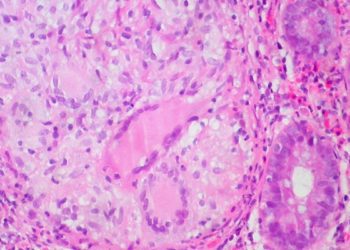Switching from ticagrelor to clopidogrel may demonstrate benefit in patients with large body mass index and prior myocardial infarction
1. A deescalation strategy involving switching from ticagrelor to clopidogrel in patients with acute myocardial infarction (AMI) was associated with improved clinical outcomes in those with lower body mass index (BMI) but not those with higher BMI.
Evidence Rating Level: 1 (Excellent)
Study Rundown: The current standard of care for individuals with AMI involves percutaneous coronary intervention (PCI) followed by antiplatelet therapy. One topic of investigation involves the optimal antiplatelet agent to use. The TALOS-AMI trial showed improved outcomes in patients with AMI who underwent PCI and who underwent a deescalation strategy involving a switch from aspirin and ticagrelor to aspirin and clopidogrel after 1 month. However, the association between BMI and optimal antiplatelet agent remains to be determined. This study therefore sought to investigate the asociation between BMI and the outcomes of the aforementioned deescalation strategy in the TALOS-AMI trial.
In this randomized, non-inferiority trial, 2697 patients were randomized to a deescalation group at the end of 1 month involving a switch to aspirin plus clopidogrel and a control group involving continuous aspirin plus ticagrelor. The primary outcome of concern was a composite of cardiovascular death, myocardial infarction, stroke, or bleeding type 2, 3, or 5 according to Bleeding Academic Research Consortium (BARC) criteria from 1 to 12 months. In patients with BMI less than 28, the rate of the primary outcome was significantly less frequent in the deescalation group compared to the control group. However, in patients with BMI greater than 28, there was no significant difference in the incidence of the primary outcome between the deescalation group compared to the control group.
Overall, this study found that the use of a deescalation strategy involving a switch from aspirin and ticagrelor to aspirin and clopidogrel 1 month following PCI for AMI was associated with improved outcomes in patients with lower BMI but not in patients with higher BMI.
Click to read the study in JAMA Network
In-Depth [randomized, non-inferiority trial]: AMI remains one of the leading causes of mortality around the world. The current standard of care for patients with AMI involves PCI followed by antiplatelet therapy with aspirin and a P2Y12 inhibitor. However, the optimal P2Y12 inhibitor remains to be determined given the risks of bleeding with different P2Y12 agents. Previously, the TALOS-AMI trial showed improved outcomes in patients with AMI who underwent a deescalation strategy involving a switch from aspirin and ticagrelor to aspirin and clopidogrel after 1 month. However, an important phenomenon related to acute coronary syndrome outcomes in patients receiving PCI is the obesity paradox, which indicates a higher mortality in patients with lower BMI than higher BMI. Indeed, the association between BMI and the optimal P2Y12 agent remains to be determined. This study therefore sought to investigate the asociation between BMI and the outcomes of the aforementioned deescalation strategy in the TALOS-AMI trial. In this randomized, non-inferiority trial, 2697 patients (mean [SD] age, 60.0 [11.4] years; 83.2% male) from South Korea were randomized to a deescalation group at the end of 1 month involving a switch to aspirin plus clopidogrel (n = 1349) and a control group involving continuous aspirin plus ticagrelor (n = 1348). Patients were followed between February 2014 and January 2021. The primary outcome of concern was a composite of cardiovascular death, myocardial infarction, stroke, or bleeding type 2, 3, or 5 according to Bleeding Academic Research Consortium (BARC) criteria from 1 to 12 months. In patients with BMI less than 28, the rate of the primary outcome was significantly less frequent in the deescalation group compared to the control group (53 [4.6%] vs 98 [8.3%]; adjusted hazard ratio [AHR], 0.54; 95% CI, 0.39-0.76). For patients with a BMI greater than 28, the incidence of the primary outcome between the deescalation group and the control group was not significantly different (6 [3.3%] vs 5 [3.2%]; AHR, 1.07; 95% CI, 0.33-3.50).
Image: PD
©2025 2 Minute Medicine, Inc. All rights reserved. No works may be reproduced without expressed written consent from 2 Minute Medicine, Inc. Inquire about licensing here. No article should be construed as medical advice and is not intended as such by the authors or by 2 Minute Medicine, Inc.







